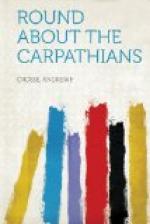The first time I drove through Bodrog-Keresztur, which is on this side, I thought that, notwithstanding the pretty country, I had never seen so desolate a place. The town was once famed for its markets, but the railways have changed all this; almost every other house is a ruin, and large trees may be seen growing between the walls.
In the last century a company of Russian soldiers were stationed here for the purpose of buying Tokay wine for the Russian Court.
One of the prettiest little places in the Hegyalia is Erdoe-Benye; it is off the main road, right in amongst the hills. It boasts the largest wine-cellar in the whole district; it has twenty-two ramifications at two different levels, the whole being cut out of the solid rock; it is more like a subterranean labyrinth than a cellar. This place was formerly the property of the renowned family of Rakoczy, who played no mean part in Hungarian history. Not far from Erdoe-Benye are mineral-water baths, romantically situated in the oak-forest.
Saros Patak and Uihely are the two most noteworthy towns in the north-eastern side of the Tokay triangle. The first named has a Calvinist college of some considerable reputation, a library of 24,000 volumes, a printing-press, and a botanical garden. Uihely is the county town of Zemplin. An agricultural show was held here last spring (1877), which I attended. Our English-made agricultural implements were very much to the fore on this occasion. Some people complain of these machines on the score of their getting out of order rather easily, and of the immense difficulty of having them repaired in the country. This objection, I have heard, does not apply alike to all the English makers. At this show there were some new kinds of wine-presses which attracted a good deal of attention; before long no doubt not a few changes will be effected in the process of wine-making in Tokay. Considering that Hungary holds the third rank in Europe as a wine-producing country, the whole question of the manipulation of wine is a very important one for her.
Amongst the live stock at this show I noticed some very fine merino sheep. In Hungary the wool-producing quality is everything in sheep, as mutton has hardly any value. This was only a country show, and the horses, from an Englishman’s point of view, were not worth looking at; but there are plenty of fine horses in Hungary. The Government has been at immense pains to improve the breed by introducing English and Arabian sires. For practical purposes the native breed must not be decried; the Hungarian horse, though small, has many excellent qualities. For ordinary animals the prices are very low, which fact does not encourage the peasants to take much care of the foals. On this occasion I bought a couple of horses for farming purposes; the two only cost me about L11.
With regard to farming, our English notions of “high farming” will not do in Hungary; what is called the “extensive system” pays best. For instance, if I were already farming, and had some disposable capital at hand, I should find it pay me better to invest in buying more land than in trying to increase the produce of what I had already in hand. After some practical experience in the country, I have no hesitation in saying that Hungary offers a good field for the employment of English capital.




